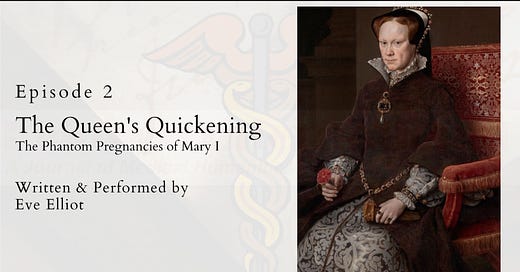In November 1554, the people of England believed a miracle had taken place.
Resplendent on her new throne, Queen Mary I, daughter of Henry VIII, proudly revealed that she was with child. She was thirty-seven, (past the usual childbearing age in the Tudor era), and had only been married to her much younger cousin Prince Philip of Spain since July. Few had believed that the politically motivated, wildly unpopular union between England and Spain would produce an heir, yet within weeks of the wedding, Mary had started showing all the signs of pregnancy.
Her courtiers, counselors, and subjects were ebullient with joy; ambassadors to Mary’s father-in-law, the Holy Roman Emperor, reported ‘There is no doubt that the Queen is with child, for her stomach clearly shows it and her dresses no longer fit her’, and ‘The Queen is in excellent health and three months with child. She is fatter and has a better colour than when she was married, a sign that she is happier, and indeed she is said to be very happy.’ When she claimed to have felt the baby move, an important milestone to reach in any pregnancy, a service of thanks for the ‘Queen’s quickening’ was held , and preparations for the royal birth began.
Everyone fervently hoped (and even presumed) that the child would be male, a future Catholic King who would restore the religion that Henry VIII had ripped apart in his own pursuit of a male heir. With the birth of a boy, Mary believed the upheaval of the previous decade would be undone, the fractured country would be reconciled to the true faith, and the years of persecution and suffering she and other Catholics had endured would be vindicated. Mary would at last know the joy of motherhood, which she considered her primary purpose as woman, wife and Queen.
By the spring of 1555, however, Mary’s physicians were gravely concerned. She had begun to show signs of mental instability during her pregnancy, and had lost her appetite to the point that her doctors worried the baby would not receive enough nutrition to survive. When she entered her ‘confinement’ (a six-week period of virtual isolation within a dark, overheated chamber — a common practice for expectant mothers at the time), her female attendants reported alarming behaviour. They described how she would spend her days curled up in the fetal position on the floor, sobbing inconsolably, or else rocking on the floor with her knees pulled up to her chest, (a near physical impossibility for a heavily pregnant woman) mumbling to herself.
Gradually everyone began to fear the worst; either Mary had miscarried, or she had never been pregnant in the first place.
As April drew to a close, news that the Queen had given birth to a boy was mistakenly announced to the public. The country erupted with jubilation, but the celebrations were short lived when the truth was revealed. By June, there was still no sign of a baby.
At first Mary claimed that her timing had simply been off, and that she would deliver her child by July. Although most of her counselors were dubious, Mary’s female attendants encouraged her belief that the baby would arrive soon. They were, perhaps, being compassionate and mindful of Mary’s disintegrating emotional state.
As July wore on, Mary decided that God must be angry with her. Echoing her father’s supposed belief that his lack of a male heir was God’s punishment for his and Catherine of Aragon’s unlawful marriage, Mary believed that God would not allow her to go into labour until Protestantism had been purged from the country. This led to the Marian Persecutions and the condemning of nearly three hundred Protestants to the flames for heresy, which would earn her the grim epithet “Bloody Mary”.
And yet, in spite of her zeal for appeasing God, He apparently continued to disapprove. By August 1555, eleven months into her supposed pregnancy, even Mary could no longer avoid the truth: there was no baby.
Mary emerged from her confinement rail-thin, sickly, and humiliated. There was no further mention of a forthcoming heir — at least in front of the Queen. Rumours abounded in alehouses and market stalls that Bloody Mary had given birth to a monkey or a dog, or that the child had been stillborn and quietly removed, or that her desperate courtiers had sought a substitute child to pass off as the royal heir. Despised by the public for her Spanish husband and the sickening slate of public burnings, Mary was an easy target for humiliation and ridicule. Her misery would only deepen when her husband, upon learning she was never pregnant, promptly left her.
Prince Philip left England in September 1555, despite Mary’s tearful pleas that he remain. Described as “extraordinarily in love” with her husband, she was heartbroken and inconsolable, grieving for his loss as if he had died. She did not see him again until 1557, when he briefly returned to ask for her financial help waging war. After his visit, which was to be his last, Mary again convinced herself that she was pregnant.
This time, her advisors considered her symptoms those of menopause, but her waiting women continued to humour her and perpetuate the fantasy that she would soon deliver a child. Only one of her ladies, a midwife by the improbable name of Frideswide Strelley, was honest with her about not being pregnant at all, for which Mary later thanked her.
"Ah, Strelley, Strelley, I see they all be flatterers, and none true to me but thou." - Mary I
By October of 1558, over a year since she had announced herself with child, Mary finally had to concede that there would be no baby this time either. Within a month, the heartbroken, mentally unstable and miserable Queen was dead, having failed to produce an heir or to restore England to the Catholic faith. Her hated half-sister Elizabeth ascended the throne, enshrined Protestantism as the state religion, and went on to reign successfully for forty-five years.
So what was behind Mary’s baffling ‘pregnancies’? Scholars believe there are several possible explanations.
Mary may have experienced pseudocyesis , a syndrome typified by the physical signs and symptoms of pregnancy in a non-pregnant person, usually linked to past emotional trauma, depression, or an intense desire to have a child. The condition is rare, especially in the modern era of readily available pregnancy tests and diagnostic imaging. Today, false pregnancy occurs in about 1 to 6 out of every 22000 births, although the occurrence rises to as much as 1 out of 160 in developing countries, where women are less likely to receive pre-natal health assessments.
While a definitive diagnosis is impossible at a distance of nearly 500 years, what is now known about the condition (namely that it can arise from physical or psychological disorders, or both) aligns with Mary’s documented symptomatology. She was known to have experienced irregular periods and debilitating menstrual cramps since puberty, and had grown up under constant emotional turmoil and distress.
Born a beloved princess, by the age of ten her father had stripped Mary of her title, declared her a bastard, and made her serve as lady-in-waiting to her infant half-sister Elizabeth. When she refused to acknowledge her own illegitimacy or her father’s self-appointed role as head of the church in England, she was imprisoned, deprived of food and warm clothing, and prevented from seeing her dying mother or attending her funeral. Ultimately faced with the subtle threat of execution, Mary finally acquiesced and wrote a grovelling letter to her father, something she regretted the rest of her life.
Other researchers have suggested organic disease as the cause of her symptoms. Dr. Milo Keynes noted in a 2000 paper that he believes Mary suffered from a pituitary tumor, and that the resultant hormonal imbalances were responsible for the wide variety of symptoms she was known to exhibit; hypothyroidism would have caused the loss of her eyebrows, headaches, weight gain, constipation leading to abdominal distension, and mental confusion; over-secretion of prolactin would have accounted for her lack of periods, galactorrhea, and even depression. As possible proof of his theory, he referred to the 1554 portrait of the 38-year-old queen, in which her flushed, puffy face, receding hairline and pale skin indicated possible hypothyroidism.
Another possibility is that Mary suffered from ovarian or uterine cancer, or ovarian dropsy (cysts on the ovary which can grow so large as to cause intense abdominal pain, of which Mary often complained). The leading theory as to her cause of death implicates cancer, but as she died during a virulent outbreak of influenza, some have speculated that this was, in fact, what killed her.
One thing is for certain; there were no miracles for Mary.
Of all the artifacts, documents and letters left to us from Mary’s short reign, perhaps the most poignant is a small prayer book, now on display at the British Museum, which falls open naturally to a page on which is printed two prayers: one for the unity of the Catholic Church, and one for the safe delivery of a woman in labour. The lines are difficult to read, as the ink is blurred and the pages are stained with tears.
References:
Rebecca Larson, “Queen Mary’s False Pregnancies”, TudorsDynasty.com. Accessed January 2, 2022 https://tudorsdynasty.com/queen-marys-false-pregnancies/
Brenda Ralph Lewis, “Was Queen Mary Really England’s Most Hated Queen?”, BritishHeritage.com. Accessed January 3, 2022. https://britishheritage.com/history/queen-mary-tudor
Susan Abernethy, “The Illnesses and Death of Queen Mary I”, TheFreelanceHistoryWriter.com. Accessed December 18, 2021. https://thefreelancehistorywriter.com/2018/02/23/the-illnesses-and-death-of-queen-mary-i/
Larson, “Queen Mary’s False Pregnancies”.
Waller, Maureen. Sovereign Ladies: The Six Reigning Queens of England. (New York: St. Martin's Press, 2006), 85.
Jean Mary Stone, “History of Mary I, Queen of England”, (London: Sands&Company, 1901), 351, https://www.gutenberg.org/files/56875/56875-h/56875-h.htm#CHAPTER_XII
Tarín, J. J., Hermenegildo, C., García-Pérez, M. A., & Cano, A. (2013). Endocrinology and physiology of pseudocyesis. Reproductive biology and endocrinology : RB&E, 11, 39. https://doi.org/10.1186/1477-7827-11-39
Marilee Hanson, "Letter of Princess Mary to King Henry VIII, 1536”, EnglishHistory.net. Accessed Dec 29, 2021. https://englishhistory.net/tudor/letter-of-princess-mary-to-king-henry-viii-1536
Milo Keynes “The Aching Head and Increasing Blindness of Queen Mary I”. Journal of Medical Biography, 2000, Volume 8, pages 102-109
Jean Mary Stone, “History of Mary I”.









Share this post